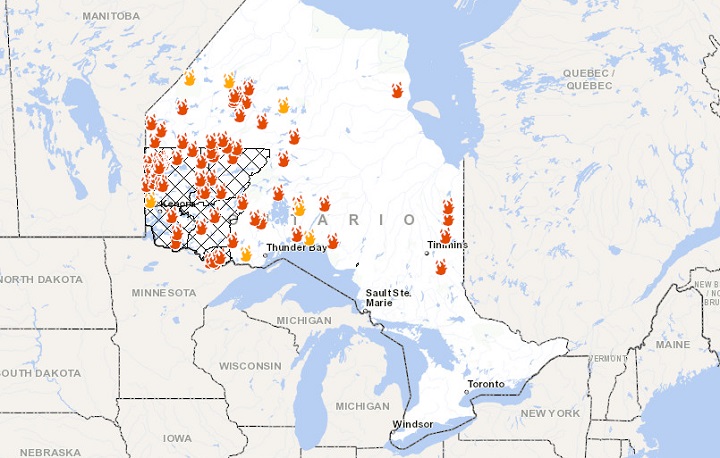While many parts of southern Ontario have been dealing with wetter weather conditions in recent weeks, it’s a dramatically different story in the province’s northwest as emergency crews are battling a surge of forest fires.

According to data from the Ontario Ministry of Northern Development, Mines, Natural Resources and Forestry, there are more than 70 active fires occurring in the northern part of the province currently.
Chris Marchand, a ministry fire information officer based in Dryden, told Global News the region, particularly in the Red Lake and Sioux Lookout areas, have been dealing with high-to-extreme fire conditions that have been fuelled by two weeks of hotter, drier weather — remnants of a system that recently saw temperature records shattered on the west coast.
“When you go this long without any significant rainfall, you get less moisture in the soil and that means fires dig in deeper and burn deeper, which extends suppression effort when you’re putting a fire out,” he said.
“That poses a lot of real challenges for firefighting in the sense of you need more in terms of aerial suppression – water bombers to help reduce fire intensity to help ground crews get established on a fire.”
Marchand said there have been about 200 more fires than are typically seen by this time of year. However, he noted the total landmass affected is less than typically seen in previous years.
He said the current active fires are all in areas near low population density and often smaller fires are left to burn under observation (officials have noted this can encourage new growth). Marchand said Woodland Caribou Provincial Park, part of the Red Lake district, has several fires.
The fire dubbed Fort Frances 47, which is around three kilometres from Naicatchewenin First Nation, posed a risk to the community, but Marchand said things have receded in recent days.
As of Friday, the biggest fire was Kenora 51. He said approximately 51,000 hectares have burned and added Kenora 51 is the one that’s putting up most of the smoke in the northern part of the province.
As for the cause of the fires, Marchand said lightning is typically the primary factor and that human-caused fires are typically seen near communities (the current fires are largely away from such areas). He noted a restricted fire zone is currently in a large section of northwestern Ontario.
“This most recent heatwave, long periods of heat and no real break in that type of weather, no real widespread precipitation to help out the forest fire situation overall again has not been a real big help to them,” Coulson said, adding there isn’t notable precipitation in the weather pattern forecast over the next month.
“On those days where they may get a bit of thunderstorm activity, the concern is not so much in the rainfall those thunderstorms may provide but the concern is the lightning those storms may possess which could then generate more in the way of forest fire activity.”

Get daily National news
Coulson noted a lack of a snowpack from the winter and a lack of rainfall at the beginning of springs contributed to this season’s drier conditions.
He went on to emphasize how the two ends of Ontario have been facing different conditions in recent weeks thanks to a frontal boundary that has concentrated weather activity in the south.
“I think looking at the weather pattern over the last few weeks in southern Ontario, it’s been dramatically different than what we saw in northwestern Ontario. We’ve been in a much more active weather area,” Coulson said.
Meanwhile, Marchand encouraged people in the region to monitor the progress of the fires on the Ontario government’s forest fires website and to be aware of the developing conditions — especially given the current demands facing firefighters.
“The resources that we have to deploy to fires are under great demand at the moment and the big challenge is knowing how to deploy those resources properly and appropriately to fires on the landscape and to maintain enough ability to respond to new situations,” he said.
“We really want to guard our capacity to respond to new fires as they emerge on the landscape.”












Comments